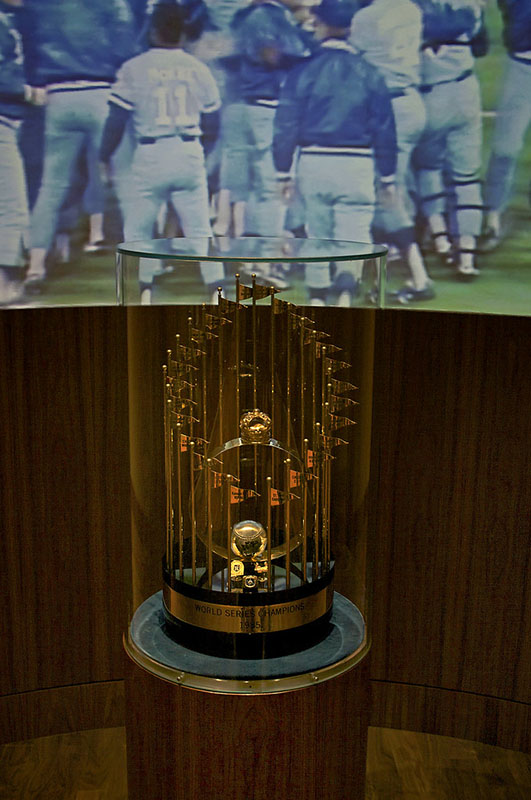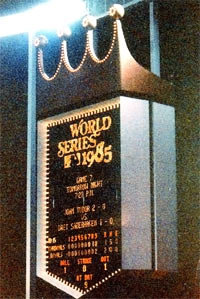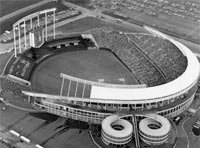When Ewing Marion Kauffman offered $10 million in 1968 for an American League expansion team in Kansas City, he had high hopes; but nobody could have imagined how successful the Royals would become in such a short period of time.
A string of successes that included division championships and a World Series appearance in 1980 was capped in 1985 when the Royals defeated their cross-state rivals, the St. Louis Cardinals, in seven games to secure the organization's first World Series title.

Starting in the mid-1970s, the Royals followed the example of their founder—who started a pharmaceutical business in his mother's basement in 1950 that grew into a multi-million dollar company—by quickly establishing a record of success. They won five American League Western Division titles after 1976. The first three of these playoffs appearances ended in frustrating losses to the New York Yankees. In 1980, the Royals finally defeated the Yankees and made it to the World Series, but lost to Philadelphia. After two more seasons in which the Royals reached the playoffs but failed to get to the World Series—in 1981 and 1984—they made the World Series again in 1985 and faced the St. Louis Cardinals.
At the outset of the 1985 World Series, it appeared that a championship would remain elusive for the Royals. They had struggled in the American League Championship series against the Toronto Blue Jays. Toronto rolled to a 3-1 series lead, forcing the Royals to claw back to a 4-3 series win.
Many pundits predicted St. Louis would win in just four or five games. On cue, the Cardinals jumped out to a 3-1 series lead, including two victories in Kansas City. No team had ever come back from losing the first two games at home, but the Royals were not deterred. They won game five, forcing the series back to Kansas City with the Cardinals leading three games to two.
In the sixth game, the Cardinals led 1-0 at the start of the ninth inning. A controversial call by umpire Don Denkinger ruled Royals' hitter Jorge Orta safe at first base, when replays showed that he should have been out. Orta was later thrown out at third base, so that the call didn't directly influence the outcome of the game. In the Royals' next at bat, Steve Balboni hit a routine pop fly in foul territory that the Cardinals failed to field. That would ultimately represent the tying run.

"The call" remains etched in the minds of St. Louis fans who believed the umpiring was unfair throughout the series. In any case, the Cardinals seemed to lose their poise after Denkinger's first base call, and the Royals scored twice to win game six and tie the series at 3-3. In the 24 years since the game was played, many fans have forgotten another call—one that benefited the Cardinals. In the fourth inning of game six, the Royals' Frank White appeared to have stolen second base, but was called out. The next batter, Pat Sheridan, hit a single to right field that would have allowed White to score the go-ahead run for the Royals.
Compared to the drama of game six, the seventh game of the series on October 27, 1985 was a cakewalk for the Royals. Playing at home in Royals Stadium, the Royals won by an astounding 11-0 to finish off the improbable upset bid against their rivals and claim the World Series title. The victory and subsequent celebration was perhaps the greatest sports moment in Kansas City history.
Such moments are often fleeting, however. The Royals remained competitive into the 1990s, but eventually the balance of power shifted back to larger-market teams like the New York Yankees, that could spend more aggressively on player trades. The Royals would not return to the World Series until 2014. They won the Series again in 2015. *
Kansas Citians will always have the memories of the 1985 underdog champs.
* This post was updated on October 27, 2014 to reflect the 2014 Major League Baseball post-season, and again on November 3, 2015 to reflect the 2015 Major League Baseball post-season.
Read full biographical sketches of players and others involved in the 1985 World Series victory, prepared for the Missouri Valley Special Collections, the Kansas City Public Library:
- Daniel R. Quisenberry (1953-1998), Kansas City Royals pitcher, by Kimberly R. Riley.
- Biography of Ewing Kauffman (1916-1993) and Muriel Kauffman (1916-1995), Kansas City Royals owners and philanthropists.
View images of the Royals that are a part of the Missouri Valley Special Collections:
- Kauffman Stadium; aerial view.
- Truman Sports Complex; aerial view.
Check out the following books and videos about the Royals, held by the Kansas City Public Library:
- Crowning the Kansas City Royals: Remembering the 1985 World Series Champs, by Jeffrey Spivak.
- This One's for You: 1985 World Champion Royals, by the sports and photo staffs of the Kansas City Star and the Kansas City Times.
- Unions to Royals: The Story of Professional Baseball in Kansas City, by Lloyd Johnson, Steve Garlick, and Jeff Magalif.
- The Story of the Kansas City Royals, by Sara Gilbert; a children's book.
- Denny Matthews's Tales from the Royals Dugout, by Denny Matthews, with foreword by Frank White.
- "Glory Shines, Undimmed by Years," in the Kansas City Star, August 13, 2005.
- "The Thrill of It All," VHS documentary, produced by Kansas City Royals Baseball Club, George Roy, Geoff Belinfante; written by Hal Fischer.
- The History of the Kansas City Royals, by Richard Rambeck.
- The History of the Kansas City Royals, by Wayne Stewart.
- Prescription for Success: The Life and Values of Ewing Marion Kauffman, by Anne Hodges Morgan.
- The Philosophies of Mr. K: Simple Truths from a Remarkable Entrepreneur and Philanthropist, by Ewing Marion Kauffman.
- "Mr. K, a Kansas City Legend: Death of Ewing M. Kauffman," VHS documentary, WDAF television station: Kansas City, Missouri.
Continue researching the Royals using archival material held by the Missouri Valley Special Collections:
- Vertical File: Baseball--Royals.
- Vertical File: Brett, George; royals star hitter.
- Vertical File: White, Frank; second baseman.
- "Royals 25: 1993 Fan Guide, 25th Anniversary Keepsake Edition;" published by the Royals baseball team.
- Vertical File: Jackson, Bo (Vincent Edward); first played for the Royals in the 1986 season.
References:
Randy Covitz, "Day for a Parade - Series Title Remains Kansas City's Greatest Moment as a Sports Town," Kansas City Star, April 3, 2005.
Dory DeAngelo, What About Kansas City!: A Historical Handbook (Kansas City, MO: Two Lane Press, 1995), 104-106.
Brenn Jones, "The Year the Royals Reigned," Kansas City Star, April 17, 2005.
Rick Montgomery & Shirl Kasper, Kansas City: An American Story (Kansas City, MO: Kansas City Star Books, 1999), 341.
Jeff Passan, "Glory Shines, Undimmed by Years," Kansas City Star, August 13, 2005.
Sherry Lamb Schirmer, At the River's Bend: An Illustrated History of Kansas City: Independence and Jackson County (Woodland Hills, CA: Windsor Publications, 1982), 148-151.
Jeffrey Spivak, "KC to SL: Get Over It!," Kansas City Star, May 22, 2005.
Jeffrey Spivak, "The Top 5 Reasons Why St. Louisans Can't Get Over the 1985 World Series," Kansas City Star, May 22, 2005.


